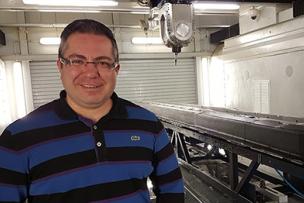Creep-feed grinding
An alternative to machining, creep feed grinding uses diamond rolls to dress the grinding wheel for accurate form and finish.
Steering rack
Project requirements: High volumes, low cycle times
Traditional process stages
- Bar stock turned, cut
- Drilling, milling
- Rack teeth broached
- Heat treatment
- Straightening, polishing
Process challenge
If the time to cut the teeth in the rack (about 30 sec.) is taken separately, then it would be difficult for grinding to complete the part. Broaches take up a lot of floor space, and large, sharp broaching tools require special care during handling. Shimming or manual adjustments by skilled operators are needed to get the required accuracy once a broach is in the machine. Once the setup is complete and production starts, part quality degrades as the tool dulls. As a rack tooth forms, pitch and surface finish change, then steering assembly performance suffers. Tool maintenance, storage, planning, and logistics add to the cost of each rack.
Switch to grinding results
- Tooling cost: Grinding 18% of broaching
- Setup time: Grinding 38% lower than broaching
- Total process costs: Grinding 53% of broaching
- Secondary benefits: Improved quality, process stability, surface finish; tooth-spacing variance cut in half
Stainless steel exhaust manifold
Project requirements: Reduce tool cost, simplify multiple machining stages
Machining processes
- Rough-, finish-milling passes machined two flat surfaces – 70 sec. for large surface, 40 sec. for smaller surface
- Face mill tool life: 10 parts per corner adding time for indexing inserts, projected annual insert cost: <$2 million
Process challenges
Inclusions in the castings caused milling inserts to break unpredictably; flatness problems around ports due to tool deflection; large burrs around holes in manifold required additional operations
Switch to grinding results
- Large surface finished in same time as milling
- Improved part quality
- Reduced tooling costs, tool change time, de-burring time
- Total cost saving: $250,000 per year before accounting for fewer scrapped parts, reduced need for inspection




Talk to Us!
Leave a reply
Your email address will not be published. Required fields are marked *